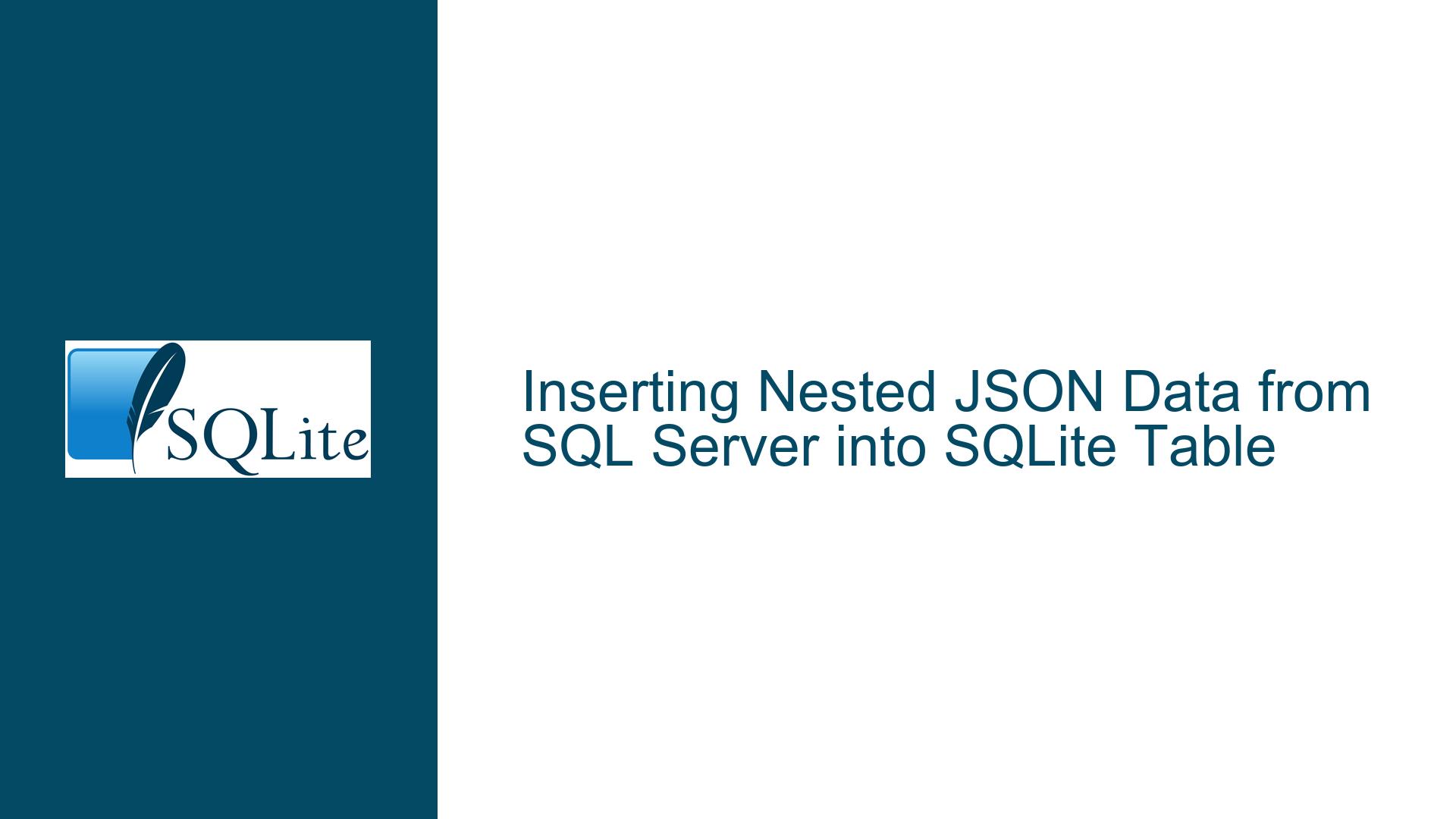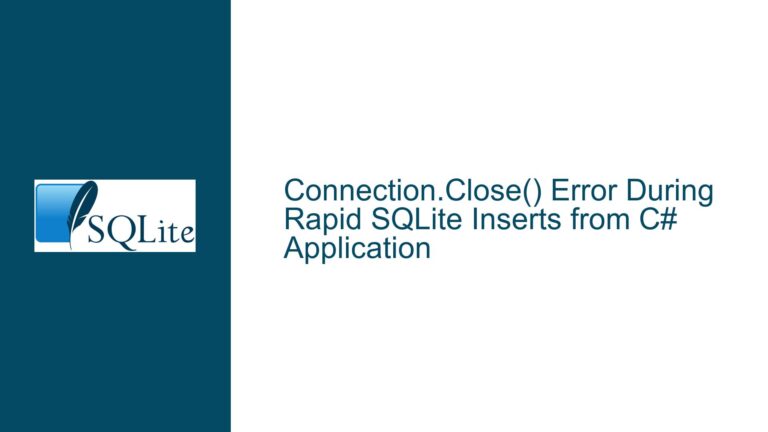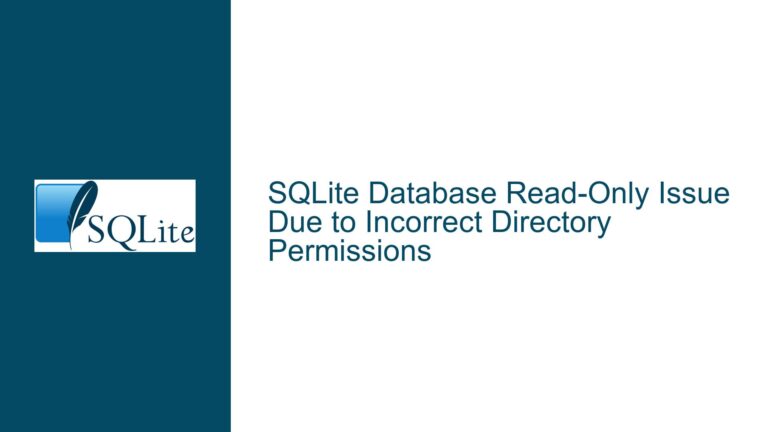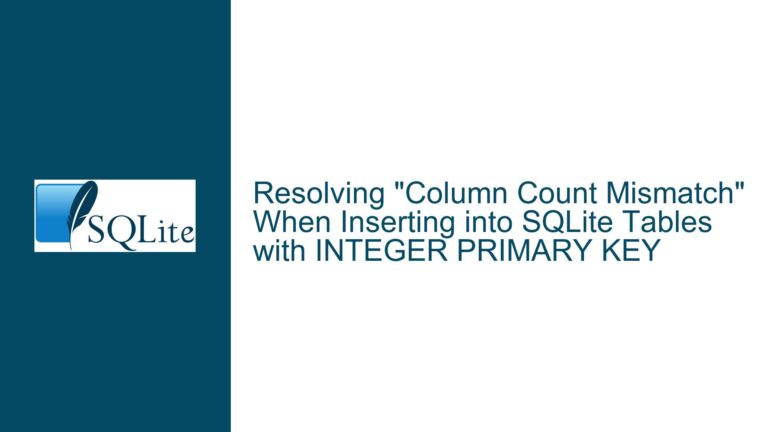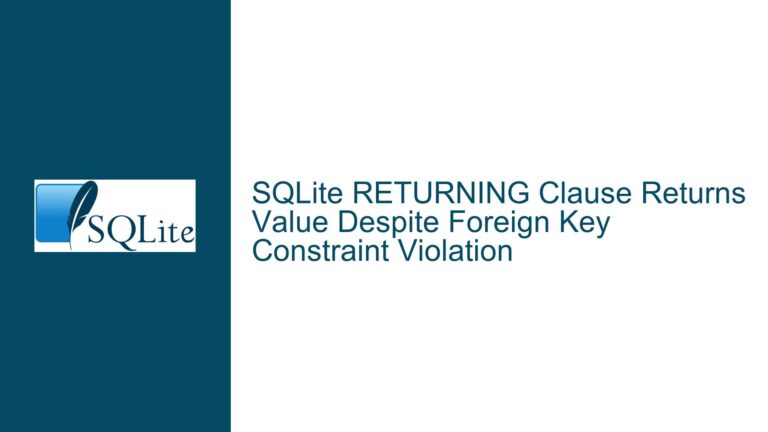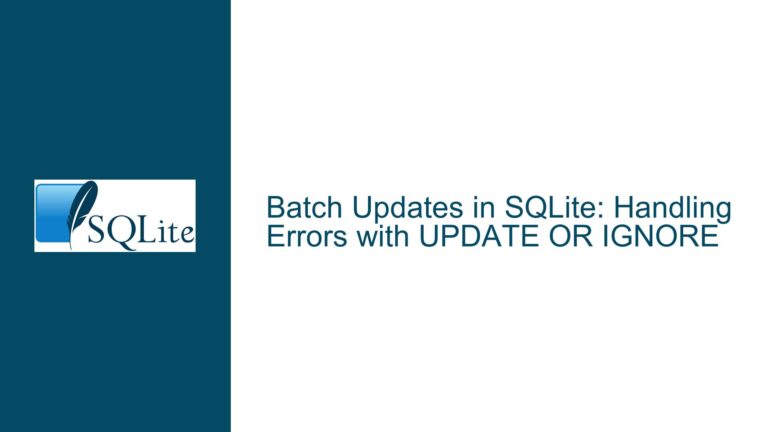Inserting Nested JSON Data from SQL Server into SQLite Table
Issue Overview: JSON Data Structure Mismatch and Insertion Failure
The core issue revolves around attempting to insert JSON data returned from a SQL Server procedure directly into an SQLite table. The JSON data is nested, with an outer array SFS101 containing multiple objects, each of which has a nested array STCARD. The SQLite table MY_SALSFSCON is designed to store flat data, meaning it expects each column to be populated with a single value per row. However, the JSON data structure includes nested arrays, which complicates the direct insertion process.
The SQLite json_tree function is used to parse the JSON data, but the query fails to correctly extract and insert the nested data into the MY_SALSFSCON table. The primary challenge lies in the mismatch between the hierarchical structure of the JSON data and the flat structure of the SQLite table. Additionally, the REGNO column in MY_SALSFSCON is an auto-incrementing primary key, which further complicates the insertion process since it requires careful handling to avoid conflicts or missing values.
The JSON data provided contains two main objects under the SFS101 array, each with a nested STCARD array. The STCARD array contains the actual data that needs to be inserted into the MY_SALSFSCON table. However, the current query only attempts to extract data from the top-level objects, ignoring the nested STCARD arrays. This results in incomplete or incorrect data insertion.
Possible Causes: JSON Parsing and Data Extraction Issues
The failure to correctly insert the JSON data into the SQLite table can be attributed to several factors. First, the json_tree function is not being used effectively to navigate the nested structure of the JSON data. The json_tree function is designed to recursively traverse JSON data, but the current query does not account for the nested STCARD arrays. As a result, the query only extracts data from the top-level objects, leaving the nested data unprocessed.
Second, the json_extract function is used to extract specific values from the JSON data, but it is not being applied to the correct nodes in the JSON tree. The json_extract function requires a path expression to locate the desired values, but the current query does not provide the correct path for the nested STCARD arrays. This results in missing or incorrect data being inserted into the MY_SALSFSCON table.
Third, the REGNO column in the MY_SALSFSCON table is an auto-incrementing primary key, which means that SQLite will automatically generate a unique value for this column if it is not explicitly provided in the INSERT statement. However, the current query does not account for this, potentially leading to conflicts or missing values in the REGNO column.
Finally, the JSON data structure itself may be contributing to the issue. The nested STCARD arrays contain the actual data that needs to be inserted into the MY_SALSFSCON table, but the current query does not correctly navigate this structure. This results in incomplete or incorrect data insertion, as the query only processes the top-level objects and ignores the nested arrays.
Troubleshooting Steps, Solutions & Fixes: Correcting JSON Parsing and Data Insertion
To resolve the issue of inserting nested JSON data from SQL Server into an SQLite table, several steps need to be taken. First, the json_tree function must be used correctly to navigate the nested structure of the JSON data. This involves recursively traversing the JSON tree to locate the nested STCARD arrays and extract the relevant data.
The json_tree function returns a table-like structure that can be queried using SQL. Each row in the result set corresponds to a node in the JSON tree, with columns indicating the node’s type, key, value, and path. By filtering the result set to include only the nodes that correspond to the STCARD arrays, the nested data can be extracted and inserted into the MY_SALSFSCON table.
Second, the json_extract function must be used correctly to extract specific values from the JSON data. This involves providing the correct path expression to locate the desired values within the nested STCARD arrays. The path expression should include the full path from the root of the JSON tree to the desired node, including any intermediate arrays or objects.
Third, the REGNO column in the MY_SALSFSCON table must be handled correctly to avoid conflicts or missing values. Since REGNO is an auto-incrementing primary key, it should not be explicitly provided in the INSERT statement. Instead, SQLite will automatically generate a unique value for this column when a new row is inserted. However, if the INSERT statement includes a SELECT clause, the REGNO column must be omitted from the SELECT clause to allow SQLite to generate the value automatically.
Finally, the JSON data structure itself may need to be modified to simplify the insertion process. If the nested STCARD arrays are not strictly necessary, they can be flattened into a single array at the top level. This would eliminate the need to navigate the nested structure and simplify the query. However, if the nested structure is required, the query must be modified to correctly navigate and extract the nested data.
To implement these fixes, the following query can be used:
INSERT INTO MY_SALSFSCON (
STATUSID, LINENO_, CLIREG, STREG, STCODE, STTRNAME, STBRACODE, STMANCODE, STUNIT1, STBARCODE1
)
SELECT
json_extract(j.value, '$.STATUSID'),
json_extract(j.value, '$.LINENO_'),
json_extract(j.value, '$.CLIREG'),
json_extract(j.value, '$.STREG'),
json_extract(c.value, '$.STCODE'),
json_extract(c.value, '$.STTRNAME'),
json_extract(c.value, '$.STBRACODE'),
json_extract(c.value, '$.STMANCODE'),
json_extract(c.value, '$.STUNIT1'),
json_extract(c.value, '$.STBARCODE1')
FROM json_tree(Json('
{
"SFS101": [
{
"STATUSID": 101,
"LINENO_": 1,
"CLIREG": 111,
"STREG": 49,
"STCARD": [
{
"STCODE": "153010101",
"STTRNAME": "SAMSUNG A21S BLACK 64BIT 649693",
"STBRACODE": "352034371",
"STMANCODE": "649693",
"STUNIT1": "Paket",
"STBARCODE1": "8806090547355"
}
]
},
{
"STATUSID": 101,
"LINENO_": 2,
"CLIREG": 111,
"STREG": 50,
"STCARD": [
{
"STCODE": "153010102",
"STTRNAME": "SAMSUNG A21S BLACK 64BIT 693649",
"STBRACODE": "352034372",
"STMANCODE": "693649",
"STUNIT1": "Paket",
"STBARCODE1": "8806090547355"
}
]
}
]
}
')) AS j
JOIN json_tree(j.value, '$.STCARD') AS c
WHERE j.type = 'object' AND c.type = 'object';
In this query, the json_tree function is used to recursively traverse the JSON data, and the JOIN clause is used to navigate the nested STCARD arrays. The WHERE clause filters the result set to include only the nodes that correspond to the STCARD arrays, ensuring that the correct data is extracted and inserted into the MY_SALSFSCON table.
By following these steps, the issue of inserting nested JSON data from SQL Server into an SQLite table can be resolved, ensuring that the data is correctly parsed, extracted, and inserted into the target table.
